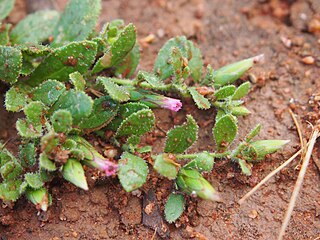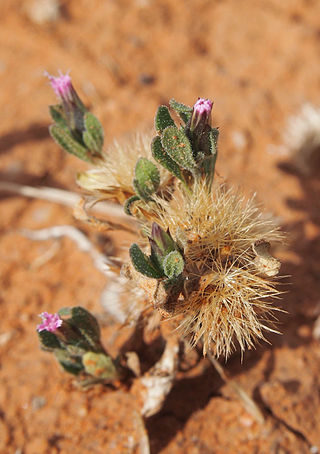
Baron Sir Ferdinand Jacob Heinrich von Mueller, was a German-Australian physician, geographer, and most notably, a botanist. He was appointed government botanist for the then colony of Victoria (Australia) by Governor Charles La Trobe in 1853, and later director of the Royal Botanic Gardens, Melbourne. He also founded the National Herbarium of Victoria. He named many Australian plants.

Pycnosorus is a genus of six species of plants in the family Asteraceae. Commonly known as billy buttons or drumsticks, they are annual or perennial herbs or small shrubs with a cylindrical to spherical head of up to 200 daisy-like "flowers". Each "flower" is a pseudanthium consisting of between three and eight florets surrounded by bracts. The petals are joined to form a small tube and the florets with their surrounding bracts are yellow or golden-yellow.

Olearia, most commonly known as daisy-bush, is a genus of flowering plants belonging to the family Asteraceae, the largest of the flowering plant families in the world. Olearia are found in Australia, New Guinea and New Zealand. The genus includes herbaceous plants, shrubs and small trees. The latter are unusual among the Asteraceae and are called tree daisies in New Zealand. All bear the familiar daisy-like composite flowerheads in white, pink, mauve or purple.

Commersonia is a genus of twenty-five species of flowering plants in the family Malvaceae. Plants in this genus are shrubs or trees, occurring from Indochina to Australia and have stems, leaves and flowers covered with star-like hairs. The leaves are simple, often with irregularly-toothed edges, the flowers bisexual with five sepals, five petals and five stamens and the fruit a capsule with five valves. The genus underwent a revision in 2011 and some species were separated from Commersonia, others were added from Rulingia.

Cassinia is a genus of about fifty-two species of flowering plants in the family Asteraceae that are native to Australia and New Zealand. Plants in the genus Cassinia are shrubs, sometimes small trees with leaves arranged alternately, and heads of white, cream-coloured, yellow or pinkish flowers surrounded by several rows of bracts.

Bedfordia is a genus of flowering plants belonging to the family Asteraceae. The genus includes 3 species, all endemic to Australia.

Asterolasia is a genus of seventeen species of erect or prostrate shrubs in the family Rutaceae, and is endemic to Australia. The leaves are simple and arranged alternately, the flowers arranged in umbel-like groups on the ends of branchlets or in leaf axils, usually with five sepals, five petals and ten to twenty-five stamens. There are seventeen species and they are found in all Australian mainland states but not in the Northern Territory.

Pluchea is a genus of flowering plants in the tribe Inuleae within the family Asteraceae. Members of this genus might be known as camphorweeds, plucheas, or less uniquely fleabanes. Some, such as P. carolinensis and P. odorata, are called sourbushes. There are plants of many forms, from annual and perennial herbs to shrubs and trees, and there is variation in the morphology of leaves, flowers, and fruits.

Spyridium is a genus of about thirty species of flowering plants in the family Rhamnaceae, and is endemic to Australia. Plants in the genus Spyridium are shrubs or subshrubs usually with small leaves, flowers usually in clusters of small composite heads, the individual flowers small and densely woolly-hairy, and the fruit a capsule. Species of Spyridium are found in all Australian states except Queensland.

Olearia axillaris, commonly known as coastal daisy-bush, coast daisy-bush or coastal daisybush is a species of flowering plant in the family Asteraceae and is endemic to coastal areas of Australia. It is an erect, bushy shrub with densely cottony-hairy branchlets, aromatic, linear to narrowly elliptic or narrowly lance-shaped to egg-shaped leaves with the narrower end towards the base and small white and yellow, daisy-like inflorescences.

Pterocaulon sphacelatum, commonly known as apple bush or fruit-salad plant, is a species of flowering plant in the family Asteraceae. It is an upright shrub with mostly pink to purple flowers and is endemic to Australia.

Joachim Steetz was a German botanist. His herbarium, comprising more than 5000 specimens from over 160 collectors and 30 countries was purchased in 1863 by Victorian Government Botanist Ferdinand von Mueller for the sum of 80 pounds. The collection is currently housed at the National Herbarium of Victoria. The herbarium was compiled by Steetz over more than thirty years and comprises 160 collectors from more than 30 countries, including type specimens from plant collectors of the time including:

Pentalepis is a genus of flowering plants in the family Asteraceae which is endemic to Australia and found only in the Northern Territory and Western Australia.

Streptoglossa cylindriceps is a species of flowering plant in the family Asteraceae and grows in Western Australia, South Australia and the Northern Territory. It is a ground cover or ascending perennial or annual herb with bluish purple or pink flowers.

Streptoglossa adscendens, commonly known as desert daisy, is a species of flowering plant in the family Asteraceae and grows in all mainland states of Australia with the exception of Victoria. It is a ground cover, upright or ascending perennial or annual herb with purple or pink flowers.

Streptoglossa decurrens is a species of flowering plant in the family Asteraceae. It grows in Queensland, Western Australia and the Northern Territory. It is an upright, aromatic perennial herb or shrub with pink-purplish or reddish purple flowers.

Streptoglossa liatroides is a species of flowering plant in the family Asteraceae. It is a low, spreading or upright perennial herb with pink or red to purple flowers. It grows in South Australia, New South Wales, Western Australia and the Northern Territory.

Streptoglossa macrocephala is a species of flowering plant in the family Asteraceae. It is a spreading or upright perennial herb with pink to purple flowers. It grows in Queensland, Western Australia and the Northern Territory.

Streptoglossa odora is a species of flowering plant in the family Asteraceae. It is a spreading, perennial herb with pink or bluish-purple flowers. It grows in Queensland, Western Australia and the Northern Territory.

Brachyscome bellidioides is a species of flowering plant in the family Asteraceae and is endemic to the southwest of Western Australia. It is an annual herb with linear leaves and yellow and white daisy-like flowers.




















